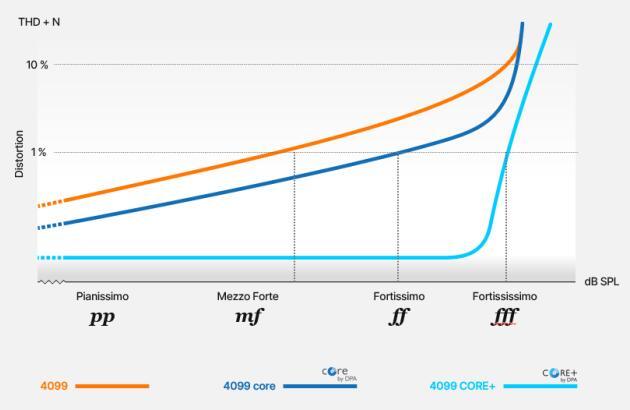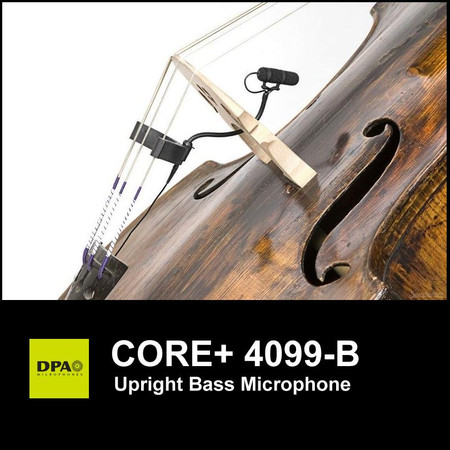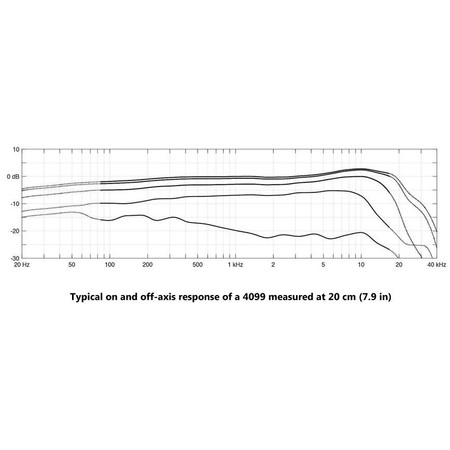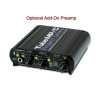DPA Microphones
DPA CORE+ (Core PLUS) 4099-B DP-1 Upright Bass Microphone
We ship worldwide! (Read this)
- FREE SHIPPING:
- To all 50 US States
- Returns Allowed:
- Special conditions apply, see below
Description
Now with CORE by DPA technology
The CORE+ (released in August 2025) model is now the only version that we have in stock. (If you're price-matching, make sure that the "great deal" you found is for the current CORE PLUS model!)
 DPA says that their new CORE+ technology "neutralizes distortion across the entire dynamic range of the microphone." This makes "any residual distortion imperceptible to the naked ear and virtually unmeasurable." You can look at the chart to the right, showing the measurable distortion levels at various loudness levels - the orange line is the original 4099 mic, the dark blue is the previous Core model, and the light blue line is the new CORE+. As you can see, the distortion level is much lower throughout the input range, and doesn't start even mildly distorting until you get to true triple forte (Fortississimo) levels.
DPA says that their new CORE+ technology "neutralizes distortion across the entire dynamic range of the microphone." This makes "any residual distortion imperceptible to the naked ear and virtually unmeasurable." You can look at the chart to the right, showing the measurable distortion levels at various loudness levels - the orange line is the original 4099 mic, the dark blue is the previous Core model, and the light blue line is the new CORE+. As you can see, the distortion level is much lower throughout the input range, and doesn't start even mildly distorting until you get to true triple forte (Fortississimo) levels.
What does that even mean? Put simply, it's better clarity with more efficient gain levels, making it far easier to dial in a sound and a mix. Openness and natural character is retained, and even when you're playing at the loudest levels, you are less likely to clip the mic or the preamp. Basically: tiny little mic; big, clear sound.
The continually updated 4099 mic has always brought more clarity and details to your music, across the entire dynamic range. The 4099 also features an enhanced shock mount design, providing excellent isolation from handling noise and rumble.
ALL of the 4099-B mics in stock at Gollihur Music are the NEW (August 2025) "CORE+" version of the mic, which is fully compatible with the add-on options (extendable gooseneck, thicker cable, wireless adapters, various instrument mounts). It also incorporates the new locking MicroLock connectors for the wire and connectors, making for a more secure connection that won't accidentally unscrew. However, the newer MicroLock connectors are backward-compatible with the MicroDot connections from all previous CORE 4099 microphones and accessories. So if you have a previous version of the gooseneck or cable, it will connect to the MicroDot with no issues (it just won't "lock.")
The 4099-B is a pro-level bass microphone from Danish company DPA; with super-lightweight construction, an integrated mounting clip system, and top-notch sound quality, could it be the perfect microphone for live upright bass?
Perhaps! Only one way to find out, though. So I sat down with the mic on one of the shop basses and checked it out. The mic uses a small-diaphragm element which has a frequency response from 20 Hz up to 20 kHz - and an effective frequency range from 80 Hz - 17 kHz (with a gentle boost in the 10-12 kHz range). The mic's highly focused supercardioid polar pattern is designed to provide the most possible gain-before-feedback. The 4099B uses a special lightweight rubber clip (see photo above), which attaches to the E and G string below the bridge; it is intended to allow you to place the mic capsule in-between the bridge and fingerboard, a popular spot for open, realistic mic'ing. Mounted to a flexible gooseneck, the mic capsule can be aimed right at the "sweet spot" on your particular bass (it's usually a little different on every bass!) to get the best sound.
The mic uses a small-diaphragm element which has a frequency response from 20 Hz up to 20 kHz - and an effective frequency range from 80 Hz - 17 kHz (with a gentle boost in the 10-12 kHz range). The mic's highly focused supercardioid polar pattern is designed to provide the most possible gain-before-feedback. The 4099B uses a special lightweight rubber clip (see photo above), which attaches to the E and G string below the bridge; it is intended to allow you to place the mic capsule in-between the bridge and fingerboard, a popular spot for open, realistic mic'ing. Mounted to a flexible gooseneck, the mic capsule can be aimed right at the "sweet spot" on your particular bass (it's usually a little different on every bass!) to get the best sound.
When I put it on the bass here, I found that pointing directly at the bass top produced a detailed, somewhat "middy" sort of tone. If I tilted the mic a little off-axis, aiming slightly towards one of the f-holes, the sound grew beefier, but lost a bit of detail. I'm sure that a bit more experimentation would have provided some other interesting results. It is a hot mic, though - all of the typical recommendations about amp placement (to avoid feedback) will apply - just as they do with any mic onstage. But the sound was clear and realistic; the tiny size of the mic belies its big - yet very transparent and accurate - sound.
Despite its diminutive size and light weight, the 4099B mic is definitely road-worthy. The mic seems as sturdy as any, and the rubber clip should hold up just fine. And I really like the small travel case that comes with it - it zips up and has a compartment for the mic to protect it during travel. Small and light, it may well fit into one of your bass bag's accessory pockets! It's nice to know that the included accessories were not an afterthought at DPA.
As for the mic itself, The gooseneck is stable and well-made; I found it easy to point the mic where I wanted to, and it held its position confidently. Since the clip mount doesn't contact the body of your bass, you don't have to worry about scratches or marks in the bass finish. To be able to mount the mic directly to the instrument is far more convenient and consistent than the traditional "mic stand approach" - we all know that it's virtually impossible to stand stock still while playing a performance (and it's not very interesting for the audience, either!) With the mic "on the bass," you can keep the mic pointed squarely at the spot you have chosen, no matter how happy your feet get. And its super-focused element seems to be more resistant to feedback on a gig - and less likely to pick up other instruments on stage - than many other general-purpose mics are.
Phantom Power: The 4099 can use standard 48V phantom power (what is phantom power?) via the included XLR connector - but will function properly on any voltage from 12-48v - so it is compatible with most any wireless system, as well as a large variety of amps and preamps.
Accessories for the DPA 4099B microphone!
The gooseneck extension can extend the existing gooseneck by an extra 80mm of length, for more precise positioning. It simply plugs "inline" with the existing gooseneck for simple installation.
You can now upgrade to a thicker, more robust cable than the one included with the DPA (which is designed to be very thin and light). The cable simply replaces the one you have; the microdot connectors disconnect from the mic end and the XLR connector and you connect the new cable in its place.
Specifications for 4099B Clip Microphone for Bass
- Directional characteristics: Supercardioid
- Principle of operation: Pressure gradient
- Cartridge type: Pre-polarized condenser
- Frequency range: 20 Hz - 20 kHz
- Frequency range, effective ± 2 dB, 20 cm (7.9 in) distance: 80 Hz to 17 kHz with 2 dB soft boost at 10 to 12 kHz
- Sensitivity, nominal, ±3 dB and 1 kHz: 6.0 mV/Pa; -44 dB re. 1V/Pa
- Equivalent noise level, A-weighted: Typ. 26 dB(A) re. 20 µPa (max.28 dB(A))
- S/N ratio, re. 1 kHz at 1 Pa (94 dB SPL): 71 dB
- Total harmonic distortion (THD): < 1% 138 dB SPL RMS, 141 dB SPL peak, < 0.5% 135 dB SPL RMS, 138 dB SPL peak
- Dynamic range: 118 dB
- Max. SPL, peak before clipping: 145 dB SPL peak
- Output impedance: From MicroLock®: 30 - 40 Ω. From DAD9099 or DAD9001: 100 Ω
- Power supply with DAD6001 XLR adapter: phantom power 48 V ±4 V; Min. 12 V (diminished gain and noise specs at lower voltages)
- Current consumption: 3.5 mA with DAD6001 XLR adapter
- Connector: MicroLock
- Color: Black
- Weight: 27 g (.95 oz)
- Microphone length: 45 mm (1.8 in)
- Cable length: 1.8 m (6 ft)
- Operating temperature range: -40 °C to 45 °C (-40 °F to 113 °F)
- Relative humidity: Up to 90 %
- Gooseneck, length: 140 mm (5.5 in)
PREAMP/PHANTOM POWER Options
Complete Package with Mic Preamp also available!
If you'd like to use a specialized condenser microphone like the DPA 4099-B with a "standard" bass amplifier, you can't just buy a cable and plug it into your amplifier input jack, for several reasons:
- The Microphone is "Active" and requires Phantom Power to operate - most amps don't provide this phantom power
- The Microphone puts out a "Mic-Level" signal, and most amps expect an "Instrument-Level" signal - you'll end up with a less-than-optimal signal
- The Microphone has an XLR (three-pin, balanced) output, and most amps have a ¼" input - a simple adapter cable is a less-than-ideal way to connect the mic to an unbalanced connection
To solve this problem, we can offer a bundled package with the ART Tube MP/C Microphone Preamp, which provides the needed phantom power so you can integrate with your exisiting setup and get studio-quality microphone sound.
The Tube MP/C preamp can accept mic-level signals, line signals, or high-impedance instrument signals; it has both a balanced XLR and a ¼" input - you can even use this as a high-impedance pickup preamp! The unit outputs both on a balanced XLR and an unbalanced ¼" jack (XLR for the mixing board, ¼" for your amp!)
The preamp is affordable, yet offers a wealth of really useful features:
- The unit puts out enough gain (up to 80 db) to drive most amps even when bypassing the internal preamp
- There are meters to monitor the levels
- Separate input and output gain controls
- Transformer-isolated XLR and 1/4" outputs can feed the house P.A. and your stage amp without adding noise
- Low cut filter to reduce low end rumble and feedback
- 20dB gain boost switch
- Inline 12AX7 preamp tube provides subtle warmth as well as adjustable drive for tonal coloration
- Phase inverter can help with feedback or clarity/tone issues
- Configurable Optical Compressor-Limiter to even out the peaks and provide a fuller, more consistent sound
- Lightweight, sturdy aluminum chassis is only 2.9 lbs, 6" x 6.5" x 1.75"
- Full product info at ART's product page
Just need simple phantom power?
Alternatively, if you already have a microphone input on your amp or mixer, but your issue is that it doesn't provide phantom power, we have an affordable, easy option for that, too: a two-channel SignalFlex branded phantom power supply. It simply goes in-between the mic and the amp/mixer, and provides the phantom power to the mic without altering the sound or signal in any other way. Inexpensive, effective.
Please note: If you have never used a microphone with your bass before, please realize that there are limitations to microphone use - that's why transducers were developed! There can be greater feedback potential, and using a mic will usually require greater care to position your bass, mic, and speakers -- and adjust EQ -- to avoid feedback, "squeal," or unwanted resonances. We include a helpful sheet with tips for avoiding feedback with every mic and pickup order.
Special return restrictions
Please note that restrictions/fees exist for returns on this item. See our return policy for details.
Videos
-

How to mount the DPA 4099 Instrument Mic on a bass with a DPA Clip
It takes less than a minute to learn how to mount a 4099 mic o...
-

Sting's recording engineer, Donal Hodgson about DPA d:vote™ 4099 mics
Sting's recording engineer, Donal Hodgson talks about DPA 4099...
-

Upright bass mic: Chris Minh Doky demonstrates his DPA 4099B Instrument Microphone
Perfect for PA amplification and live recording of acoustic up...
-

How to mic a double bass
The double bass’ lowest note is the E1, which is equivalent to...
-

Microphone cables designed to withstand the rigors of daily use
The cables we use on our mics are some of the most durable you...
Warranty Information
- Only the microphone
- Mechanical functionality
- Documented specifications
- Faults caused by mistreatment, abuse, wear and tear, alteration or modification in any way (please refer to the Users Manual)
- Accessories supplied with the product
- Minor faults or deviations in the quality of a product which do not affect the products value or fitness for its intended purpose
- The warranty is void if the product serial number has been altered or removed






























